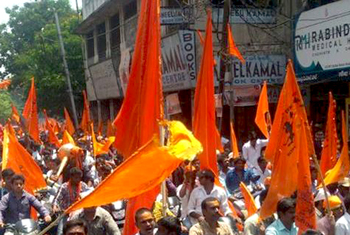Chikkamagaluru, Jul 26: A group of Hindutva activists brutally assaulted two migrant workers from northeast India after calling them Bangladeshi terrorists' near Alduru town in Chikkamagaluru taluk on Monday.
 The injured have been identified as Ohijul Sikdar (32) and Tamsorali, both were part of a group of labourers from Assam. Among them Sikdar was seriously injured when a gang of 10 activists pushed him, and hit his head, back and limbs. He was lying on the road unconscious by the time police reached the spot.
The injured have been identified as Ohijul Sikdar (32) and Tamsorali, both were part of a group of labourers from Assam. Among them Sikdar was seriously injured when a gang of 10 activists pushed him, and hit his head, back and limbs. He was lying on the road unconscious by the time police reached the spot.
The police rushed him to the government hospital in Alduru and later to the district hospital in Chikkamagaluru, where he is said to be recovering.
The incident happened around 8.30 p.m. when around 60 people, including a few children, from Assam, all hired by various estates as plantation workers, reached Alduru town in a private bus.
The workers from Assam had reached Bengaluru by train. As there was no KSRTC service on the day, they hired a private bus to reach Alduru.
As they were walking towards their respective estates, a group of Hindutva activists stopped them and asked them go back to their native land. They allegedly called them “terrorists from Bangladesh” and said they should no longer work in Chikkamagaluru. They picked up an argument with two of them and beat them up, according to the complaint registered in Alduru Police Station.
Following the incident, Alduru police registered a case on charges of attempt to murder and rioting against 10 people. Six of the accused were arrested by Tuesday morning. The arrested are Tejas, Sharat, Shivakumar, Manu Kumar, Rohit and Sudarshan. “Four other accused are absconding,” said K. Santosh Babu, Chikkamagaluru Superintendent of Police.






Comments
Why cant we call them Bajrangdal Terrorists??
WHEN MODI TOOK POWER IN CENTRAL, TILL NOW THERE IS NO SECURITY FOR THE MINORITY, AND NOW HE IS SILENT ON MINORITY ATTACKS ALL OVER IN INDIA.
THERE ARE MUCH MORE EVIDENCE TO BAN RSS, BD, VHP.....
Good.. Let world see ur real face..
Very shame...shame , no humanity very cruelty
These goons should be banned from society....if they have problem they should inform police...now police should punish them severely so that they should not take law in their hands in future.....
WHA WHA WHA THEY START NOW BEC BJP GOVERMENT PASSED ALREADY 2 YEAR ,
NOW THEY START EVERTHING ATTACHK TO INNOCENT THIS ALLL ACCHE DIN FROM MODHI SAARKAR
PEOPLE KILLED FOR COW , OTHER COUNTRY PEOPLE LAFGING IN INDIANS , WE ARE WORKING IN MIDDLE EAST THEY ARE ASKING US
HUMAN KILLED FOR COW WHAT TYPE OF COUN TRY IS INDIA SHAME ON US AND OUR MODHI GOV
Govt should spare no time in arresting the leaders of the terrorist organisatins to brutually attacked inidans from other states. These terrorists have no right to be called as Indians as they have no respect for the co-Indians. Shame on your Hindutva terrorists. Govt should ban these terrorist organisations and kick out their leaders out of Indian mainland. Hoswever, i am sorry to say that no Govt will take that step. Instead of arresting the terrorists i doubt that innocents migrants will be arrested and punished for no fault of theirs.
These so called Hindu activists are doing too much goondasm throughout the country. These people should be booked as terrorists.
Send this Bajrangis to Andaman on one way ticket and never to return to mainland
Add new comment